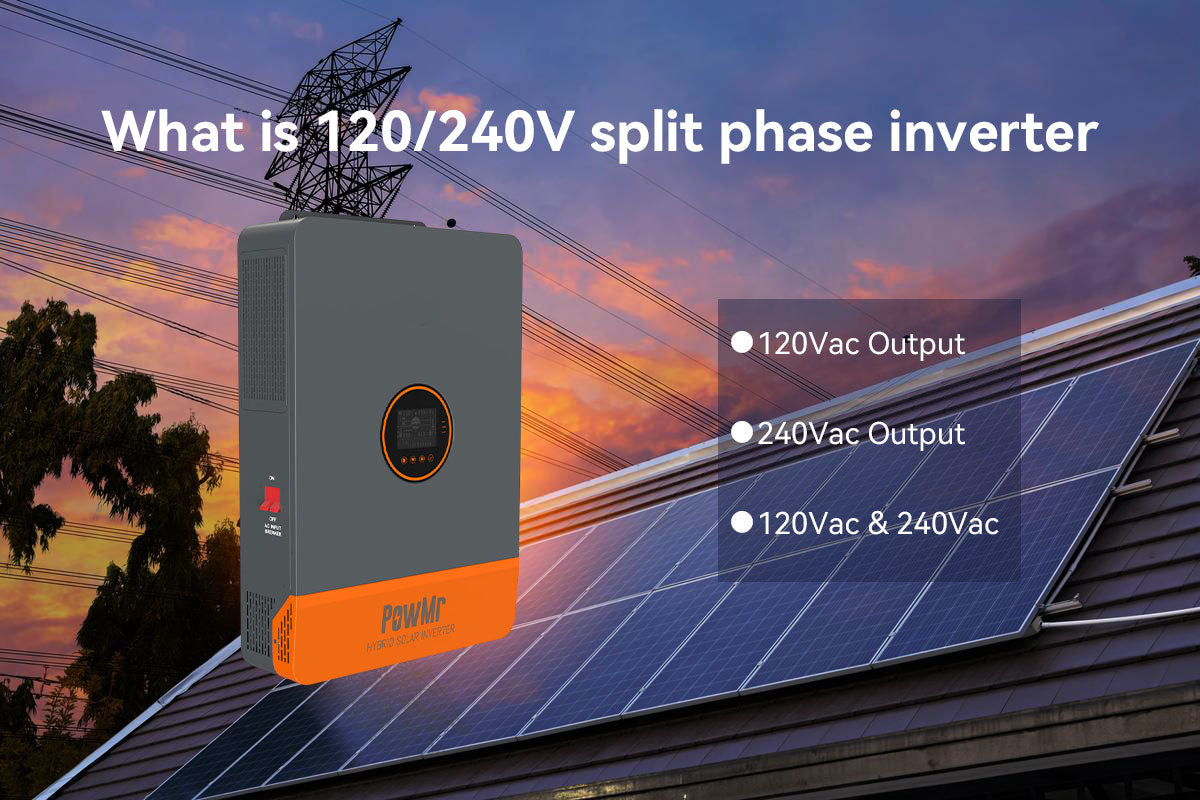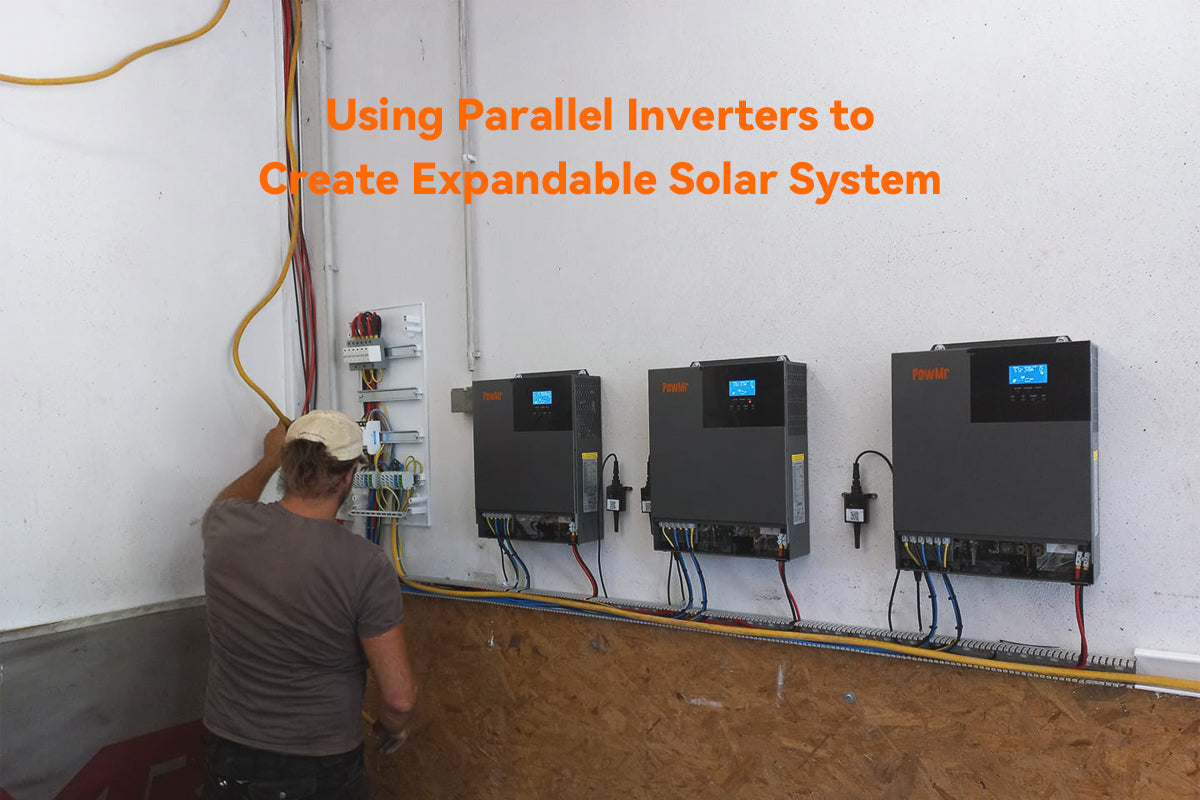สหรัฐอเมริกา, อังกฤษ และเยอรมนี เป็นสามประเทศแรกในโลกที่ใช้ไฟฟ้า และสหรัฐอเมริกาเป็นประเทศแรกที่นำเครื่องกำเนิดไฟฟ้ามาใช้และจัดตั้งระบบไฟฟ้า 110 V.
ประเทศและภูมิภาคใกล้เคียงบางแห่ง เช่น แคนาดา, เม็กซิโก, โคลอมเบีย, หมู่เกาะเคย์แมน, รวมถึงญี่ปุ่นและไต้หวัน ก็ได้นำมาตรฐานแรงดันไฟฟ้า 110 V-120 V มาใช้เช่นกัน.
แม้ว่าเครื่องกำเนิดไฟฟ้า 220 V-240 V จะถูกสร้างขึ้นหลังจากนั้น แต่ประเทศเหล่านี้ไม่ได้ใช้มาตรฐานนี้เนื่องจากต้นทุนที่สูงในการเปลี่ยนระบบพลังงาน.
เพื่อให้ตอบสนองความต้องการไฟฟ้าของประชาชนในประเทศต่างๆ อินเวอร์เตอร์แบบเฟสเดียว อินเวอร์เตอร์แบบเฟสแยก และอินเวอร์เตอร์แบบสามเฟสจึงได้เกิดขึ้นเช่นกัน ด้านล่างนี้เราจะอธิบายความแตกต่างระหว่างทั้งสามและ แนะนำอินเวอร์เตอร์แบบเฟสแยกที่คุ้มค่าทั้งสามตัว.
เริ่มต้นด้วย แนวคิดของระบบแยกเฟส ซึ่งเป็นระบบการกระจายที่พบได้ทั่วไปในประเทศในอเมริกาเหนือ และมักถูกเข้าใจผิดว่าเป็นระบบสองเฟสโดยผู้ที่ไม่มีความรู้ด้านไฟฟ้า.
เฟสเดียว vs เฟสแยก - ความแตกต่างคืออะไร?
เฟสเดียวคืออะไร?
นอกเหนือจากระบบไฟฟ้าสามสายแบบเฟสเดียว ระบบไฟฟ้าเฟสเดียวที่พบมากที่สุดคือ ระบบไฟฟ้าสองสายแบบเฟสเดียว (หนึ่งสายไฟและหนึ่งสายกลาง) ที่ใช้ในการกระจายพลังงานในแหล่งจ่ายไฟ AC โดยปกติจะมีความถี่ที่ 50 หรือ 60 เฮิร์ตซ์ แรงดันไฟฟ้าของไฟฟ้าเฟสเดียวจะพีคสองครั้งในหนึ่งรอบ และพลังงานในขณะนั้น ไม่คงที่.
การแยกเฟสคืออะไร?
การแบ่งเฟสหมายถึง ระบบการกระจายพลังงานไฟฟ้าสามสายเฟสเดียวที่มีจุดกลางเป็นกลาง ซึ่งให้ไฟฟ้าสำหรับที่อยู่อาศัยที่ 120/240 Vac.
ในตู้สวิตช์ที่ติดตั้งบนเสาแต่ละตัวของถนนหรือกลุ่มทรัพย์สิน ภายในหม้อแปลงจะมีขดลวดหลักที่เชื่อมต่อกับกริดและขดลวดขนาดเล็กที่เชื่อมต่อกับทรัพย์สิน โดยปลายทั้งสองของขดลวดรองจะเชื่อมต่อกับทรัพย์สินด้วย สายไฟฟ้าสองเส้น และ สายกลางเชื่อมต่อกับกลางของขดลวดรอง.

แรงดันไฟฟ้าระหว่าง L1 และ N และระหว่าง L2 และ N คือ 120V เมื่อวัดด้วยมัลติมิเตอร์ ในขณะที่เมื่อเราต่อสายไฟทั้งสองเข้ากับขั้วของมัลติมิเตอร์ แรงดันไฟฟ้าคือ 240V เมื่อวัดเทียบกับสายกลาง ความแตกต่างของเฟสระหว่าง L1 และ L2 คือ 180 องศา แต่ถึงอย่างนั้น ระบบเฟสแยกยังคงเป็น ระบบเฟสเดียว.
จากแผนภาพข้างต้น ชัดเจนว่านี่คือ วงจรอนุกรม กระแสที่ไหลผ่านนั้นมีทิศทางตรงกันข้ามกับ กลาง ดังนั้นความแตกต่างของเฟสระหว่างพวกมันจึงเท่ากับ 180 องศา แต่ทั้งสองรูปคลื่นแรงดันไฟฟ้าก็ อยู่ในเฟสเดียวกัน หรืออยู่ในจังหวะเดียวกัน กับกัน.
อย่างไรก็ตาม เนื่องจากระบบหลายเฟสต้องกำหนดทิศทางที่ไม่ซ้ำกันของ การหมุนเฟส ระบบแยกเฟสจึงไม่สามารถผลิต สนามแม่เหล็กหมุนที่ชี้เดียว ได้ ดังนั้นจึงเป็น ระบบเฟเดียว.
อินเวอร์เตอร์แบบแยกเฟสคืออะไร?
ในอเมริกาเหนือ เต้ารับไฟฟ้าของผู้คนจะจ่ายไฟที่ 110 โวลต์ ซึ่งบางครั้ง ถูกอธิบายว่าเป็น 120 โวลต์ เนื่องจาก การสูญเสียในระหว่างการส่งและการลดลงของแรงดันไฟฟ้า อาจทำให้สถานีไฟฟ้าจ่ายไฟที่แรงดันไฟฟ้าระหว่าง 120 ถึง 110 โวลต์ ดังนั้นอุปกรณ์ส่วนใหญ่ในประเทศอเมริกาเหนือจึงมีการจัดอันดับที่ 120/110V.
และ โหลดอุตสาหกรรมหนัก เช่น คอมเพรสเซอร์ ตู้เย็น และปั๊ม ใช้แรงดันไฟฟ้า เฟสต่อเฟส (ไฟฟ้าสดต่อไฟฟ้าสด) ที่ 220/240Vac.
อินเวอร์เตอร์แบบแยกเฟสเป็นอุปกรณ์ที่แปลงพลังงานไฟฟ้ากระแสตรงที่ผลิตโดยเครื่องกำเนิดไฟฟ้า แบตเตอรี่ หรือระบบพลังงานแสงอาทิตย์ให้เป็นพลังงานไฟฟ้ากระแสสลับ 110/240V สำหรับความต้องการพลังงานในบ้านและอุตสาหกรรมในประเทศในอเมริกาเหนือ.
อินเวอร์เตอร์แบบแบ่งเฟสทำงานอย่างไร
อินเวอร์เตอร์แบบแบ่งเฟสที่คุ้มค่าที่สุด
อินเวอร์เตอร์แบบแบ่งเฟสสามารถ ตอบสนองความต้องการ 110V/240V และด้วยการพัฒนาเทคโนโลยี อินเวอร์เตอร์ชาร์จถูกออกแบบมาเพื่อรวม การชาร์จ การปล่อยพลังงาน และการแปลงพลังงาน AC/DC ไว้ในหนึ่งเดียว ทำให้ผู้ใช้สะดวกสบายมากขึ้น สำหรับการผลิตพลังงาน PV, PowMr Sunsmart 10K เป็นอินเวอร์เตอร์แบบแบ่งเฟสที่คุ้มค่าคุ้มราคา.
โหมดเฟสแยก

อินเวอร์เตอร์แบบแบ่งเฟสที่ติดตั้งด้วย L1, L2, N ports และพอร์ต PE สำหรับผู้ที่มีการป้องกันกราวด์ เชื่อมโหลดเข้ากับ L1 และ L2 เพื่อ:
- แปลงพลังงานไฟฟ้า DC จาก ไฟฟ้าหลัก, แผงโซลาร์เซลล์ และเครื่องกำเนิดไฟฟ้า
- รับไฟฟ้า 240V ในโหมดแบ่งเฟส เพื่อใช้งานกับโหลดอุตสาหกรรมหนัก ที่เชื่อมต่อกับ L1 และ L2
- เก็บพลังงานส่วนเกิน ในแบตเตอรี่สำหรับกรณีฉุกเฉิน
โหมดเฟสเดียว
"อินเวอร์เตอร์แบบเฟสเดียวคือการแปลงแรงดันไฟฟ้า AC ที่ออกมาเป็นแบบเฟสเดียว เช่น AC 220V หรือ 230V โดยปกติแล้ว อินเวอร์เตอร์แบบเฟสเดียวจะมี 3 อินเตอร์เฟส ซึ่งมีป้ายกำกับว่า "N" "L" "PE"."
ในโหมดเฟสเดียว แรงดันไฟฟ้าขาออกของอินเวอร์เตอร์แบบแยกเฟสจะให้ไฟฟ้า 110V เพื่อใช้ในการทำงานของแอปพลิเคชันที่อยู่อาศัย/เชิงพาณิชย์ขนาดเล็ก.
ใช้ Sunsamrt 10K เป็นตัวอย่าง สามารถถือได้ว่าเป็นไฟร์ไวร์ ที่เชื่อมต่อ L1 และ L2 ซึ่งทำให้ตัวแปลงสัญญาณแบบแบ่งเฟสไม่มีความแตกต่างจากตัวแปลงสัญญาณแบบเฟสเดียว.

เคล็ดลับ
ในสถานการณ์ที่ความต้องการพลังงานภายในระบบแบบแยกเฟสมีค่า มากกว่า 10 kW ให้พิจารณาอัปเกรดเป็นผลิตภัณฑ์ล่าสุดของ PowMr คือ Sunsmart LV12K อินเวอร์เตอร์แบบแยกเฟส.
- ด้วยกำลังไฟที่ระบุไว้ที่ 10kW รองรับ การสื่อสารแบบขนาน เพื่อความสามารถในการขยายตัวสูงสุดถึง 6 หน่วย.
- มันมี ตัวควบคุมการชาร์จพลังงานแสงอาทิตย์ MPPT คู่ ขนาด 200Amp โดยแต่ละตัวมีประสิทธิภาพ 99.9% และกระแส 18A (สูงสุด PV Input) ในวงจรเดียว.
- นอกจากนี้ อินเวอร์เตอร์ยังมีฟังก์ชันการตั้งค่าการชาร์จและการปล่อยพลังงานในช่วงเวลาที่กำหนด ช่วยให้ผู้ใช้สามารถ เพิ่มประสิทธิภาพการใช้พลังงานในช่วงเวลาที่มีการใช้พลังงานสูงและต่ำ ซึ่งช่วยลดค่าไฟฟ้าได้อย่างมีประสิทธิภาพ.
การอธิบายเฟสแยก 120V/240V - วิดีโอสอน
คู่ขนานสองตัวแปลงสำหรับเฟสแยก
ในขณะที่ PowMr Sunsmart 10K มีโซลูชันแบบครบวงจรสำหรับการผลิตพลังงานแบบแยกเฟส แต่ก็มีวิธีการอีกวิธีหนึ่งในการสร้าง 110Vac จากแหล่ง 220Vac.
นี่เกี่ยวข้องกับการเชื่อมต่อ อินเวอร์เตอร์สองตัวแบบขนาน สำหรับผู้ที่พิจารณา อินเวอร์เตอร์แบบขนานเพื่อให้ได้พลังงานแบบแบ่งเฟสPOW-SunSmart SP5K อินเวอร์เตอร์พลังงานแสงอาทิตย์ 5kw ควรค่าแก่การเน้นย้ำ มันถูกออกแบบมาโดยเฉพาะสำหรับวัตถุประสงค์นี้และสามารถจับคู่กับหน่วยอื่นเพื่อสร้างแหล่งจ่ายไฟแบบแบ่งเฟสได้อย่างราบรื่น.
นอกจากนี้ยังช่วยให้สามารถเชื่อมต่ออุปกรณ์ได้พร้อมกันสูงสุดถึง 6 หน่วย โดยมีการผลิตพลังงานรวมสูงสุดถึง 30,000 kW ซึ่งทำให้เป็นตัวเลือกที่ยอดเยี่ยมสำหรับระบบพลังงานแสงอาทิตย์ขนาดใหญ่.
บันทึก:
อย่างไรก็ตาม สิ่งสำคัญคือต้องเข้าใจว่า ไม่ อินเวอร์เตอร์ทั้งหมดถูกออกแบบมาสำหรับการเชื่อมต่อแบบขนาน เพื่อสร้างการกำหนดค่าที่เชื่อถือได้แบบแบ่งเฟส คุณต้องการอินเวอร์เตอร์ที่มี การออกแบบเฉพาะ ที่สามารถทำงานร่วมกันได้อย่างราบรื่น คลิกที่นี่เพื่อเรียนรู้เพิ่มเติมเกี่ยวกับ อินเวอร์เตอร์ขนาน.
วิธีการเชื่อมต่ออินเวอร์เตอร์แบบขนานสำหรับเฟสเดียว/ เฟสแยก/ สามเฟส - วิดีโอสอน
อินเวอร์เตอร์แบบเฟสแยกหนึ่งตัวหรือคู่ของอินเวอร์เตอร์ที่เชื่อมขนาน?
อินเวอร์เตอร์โซลาร์แบบแบ่งเฟสและอินเวอร์เตอร์โซลาร์แบบขนานสำหรับระบบแบ่งเฟสมีวัตถุประสงค์ที่แตกต่างกันและมีลักษณะที่แตกต่างกัน
แต่ละวิธีมีข้อดีและข้อพิจารณาของตนเอง และการเลือกระหว่างพวกเขาขึ้นอยู่กับปัจจัยต่างๆ รวมถึงความต้องการเฉพาะของผู้ใช้.
ข้อดีของอินเวอร์เตอร์โซลาร์เซลล์แบบแบ่งเฟส
อินเวอร์เตอร์โซลาร์แบบแยกเฟสคือหน่วยอินเวอร์เตอร์เดียวที่ออกแบบมาให้ทำงานกับระบบไฟฟ้าแบบแยกเฟสซึ่งพบได้ทั่วไปในอเมริกาเหนือ (120/240V) มันสามารถสร้างพลังงานทั้ง 120V และ 240V จากอินเวอร์เตอร์เดียว นี่คือจุดสำคัญบางประการที่ควรพิจารณา:
- ความเรียบง่าย
อินเวอร์เตอร์แบบแบ่งเฟสค่อนข้าง ติดตั้งง่าย เพราะเป็นหน่วยเดียว. - ประหยัดพื้นที่
พวกเขาใช้พื้นที่ น้อยกว่า เมื่อเปรียบเทียบกับอินเวอร์เตอร์ขนานหลายตัว.
ข้อดีของการขนานอินเวอร์เตอร์โซลาร์เซลล์สำหรับระบบแยกเฟส
"อินเวอร์เตอร์โซลาร์เซลล์ขนานสำหรับระบบแยกเฟสเกี่ยวข้องกับการใช้หลายอินเวอร์เตอร์เฟสเดียวที่เชื่อมต่อกันขนานเพื่อให้ได้ผลลัพธ์แยกเฟสที่ต้องการ นี่คือจุดสำคัญบางประการ:"
- ความสามารถในการปรับขนาด
วิธีการนี้ช่วยให้ ความจุของระบบมากขึ้น คุณสามารถเพิ่มจำนวนอินเวอร์เตอร์ได้ตามที่ความต้องการพลังงานของคุณเพิ่มขึ้น. - ความซ้ำซ้อน
ถ้าหากอินเวอร์เตอร์ตัวใดตัวหนึ่งล้มเหลว อินเวอร์เตอร์ตัวอื่น ๆ สามารถ ทำงานต่อไป ได้ ซึ่งให้ระดับความซ้ำซ้อน.
- ความยืดหยุ่น
อินเวอร์เตอร์ขนานสามารถปรับแต่งให้ตรงตามความต้องการพลังงานเฉพาะของผู้ใช้ ทำให้เหมาะสมสำหรับการติดตั้งที่อยู่อาศัยหรือเชิงพาณิชย์ขนาดใหญ่.
บทสรุป
โดยสรุป การเลือกใช้เครื่องแปลงไฟฟ้าพลังงานแสงอาทิตย์แบบแบ่งเฟสและเครื่องแปลงไฟฟ้าพลังงานแสงอาทิตย์แบบขนานขึ้นอยู่กับขนาดและความซับซ้อนของการติดตั้งพลังงานแสงอาทิตย์ของคุณ งบประมาณของคุณ และแผนการขยายในอนาคตของคุณ.
ระบบที่อยู่อาศัยขนาดเล็ก มักเลือกใช้ อินเวอร์เตอร์แบบแยกเฟส เนื่องจากความเรียบง่ายและความคุ้มค่า ในขณะที่ ระบบที่ใหญ่กว่าหรือมีความยืดหยุ่นมากกว่า อาจได้รับประโยชน์จาก อินเวอร์เตอร์แบบขนาน สำหรับความสามารถในการขยายและความซ้ำซ้อน.
การปรึกษากับผู้ติดตั้งพลังงานแสงอาทิตย์หรือวิศวกรสามารถช่วยให้คุณกำหนดวิธีแก้ปัญหาที่ดีที่สุดสำหรับความต้องการเฉพาะของคุณได้



